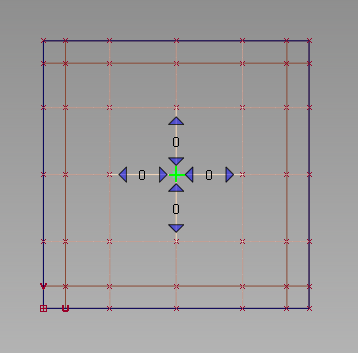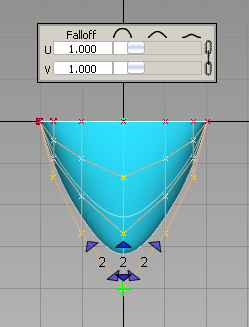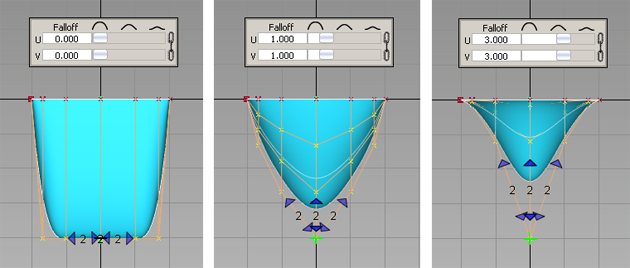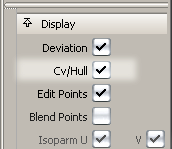Move (in space, or relative to the geometry), scale, or rotate multiple CVs at once, with the amount of transformation relative to the CVs distance from the primary CV you click.
Use the Proportional Mod tool from the Control Panel
 .
.

See Mode for a description of the different modes.
A green jack locator apears on the CV, and eight blue arrows appear around it.

 key, and click on a CV (or box-select) to select/deselect additional rows. (See Specify the selection range below for more details.)
key, and click on a CV (or box-select) to select/deselect additional rows. (See Specify the selection range below for more details.)
A numeric label shows how many rows of CVs have been selected in each direction. Selecting and deselecting CVs always maintains a "rectangular" selection.



Set Transform to Pivot if you need to move the pivot before rotating or scaling CVs. The options from Transform > Local > Set Pivot are used to determine which pivot(s) to move (Rotation, Scaling, or both).
You must first select the primary CV by clicking on it. The primary CV defines the point from which falloff is calculated and applied to the range of CVs. It is indicated by a green jack locator.

If only one CV is selected when the Prop Mod tool is invoked, it becomes the primary CV.
Small blue arrows appear around the primary CV, allowing you to select/deselect additional rows of CVs to define the range that will be affected by Prop Mod.
If you keep the mouse button depressed, rows of CVs are continuously added/removed to/from the selection. if you click and release, rows are added/removed one at a time.
A numeric label shows how many rows of CVs have been selected for each direction.

Selecting and de-selecting CVs always maintains a “rectangular” selection.
Instead of using the blue arrows, you can also select the range of CVs by holding down the  key, and:
key, and:
As with the Transform > Modify > Proportional tool, we use a range-based modification. That is, the greater the number of CVs between the primary CV and the boundary of the defined region, the less effect the transformation has on each CV.
The falloff window appears as soon as the Prop Mod tool is selected.

By default the U and V falloff sliders move in sync. To decouple them, click the chain link icon on the right hand side of the window. A value of 0.0 means that all CVs move by the same amount. A value of 1.0 (default) corresponds to a linear falloff. The higher the falloff value, the less effect the movement of the primary CV has on the surrounding CVs.

The slider settings are maintained between applications of the tool.
Apply Prop Mod across multiple surfaces
Under certain conditions, it is possible to select CVs on surfaces adjacent to the surface containing the primary CV and apply the modification across several surfaces.

Figure A: Four adjacent surfaces.

Figure B: Six adjacent surfaces forming a rectangular grid.
Alternate method: Use the Proportional Mod tool from the Palette (deprecated)
Show CVs on the picked objects
Click the Cv/Hull checkbox in the Display section of the Modeling control panel


 .
.
Transform CVs proportionally in relation to a primary CV

 .
.
The affected CVs (the number of CVs before and after the primary CV as specified in the option box) follow along, with the amount of transformation relative to their distance from the primary CV.